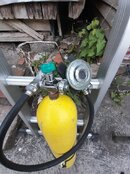Bob My guess is your going back 20 odd years here and it was an old US Divers A ClampI have a yoke reg designed for 4000# service before DOT regulation changed to DIN only for 3500# and above, probably to prevent someone using a 1800# service from over 3500# pressure which could cause a catastrophic accident rather than just blowing an o-ring.
you are referencing. Details and accuracy matter in these types of posts to me at least if I am involved but it would would be good if you were to verify.
My point on these 4000psi stamped rating on the US Divers Regulators is that they did not take into account the developed pressure generated of a full cylinder at 60 degrees centigrade and therefore had to reduce the service pressure rating down to 3500 psi to cover on later models.
Now by contrast the retail scuba sports market have no such requirement so the entire batch were sold to recreational divers with no problem. Saving considerable cost.
Nothing wrong with the clamp its a little thicker than the earlier XIV but made from the same material spec (Tensile Strength) and method of manufacture (Hot brass Stamping)
But for the rated stamped pressure of 4000 psi against the extrusion pressure due to deflection of the clamp was too close for the original application hence why they ended up with you lot getting to buy them.




